![]()
![]()
![]()
Use LEFT and RIGHT arrow keys to navigate between flashcards;
Use UP and DOWN arrow keys to flip the card;
H to show hint;
A reads text to speech;
134 Cards in this Set
- Front
- Back
- 3rd side (hint)
|
The cardiorespiratory system |
Composed of the cardiovascular & respiratory systems. |
|
|
|
What does the cardiovascular system consist of? |
Heart Blood vessels Blood |
|
|
|
What does the respiratory system include? |
Bronchi Trachea Lungs Alveoli |
|
|
|
What do the cardiovascular & respiratory systems provide the body with? |
Adequate oxygen & nutrients, removing waste products such as CO2 from the cells. |
|
|
|
The cardiovascular system is composed of blood vessels that |
Transport blood from the heart to the tissues of the body. |
|
|
|
The cardiovascular system : |

Back (Definition) |
|
|
|
Intercalated discs are |
Irregularly spaced dark bands between cardiac cells. |
|
|
|
What do intercalated discs do? |
Help hold muscle cells together during contractions, creating an electrical connection between the cells that allows the heart to contract as 1 functional unit. |
|
|
|
The heart has its own built-in |
Conduction system, sending an electrical signal rapidly throughout all of the cardiac cells. |
|
|
|
What is the typical resting heart rate? |
Between 70 & 80 beats/min |
|
|
|
The electrical conduction system of the heart consists of |
Specialized cells that allow an electrical signal to be transmitted from the sinotrial (SA) node through both atria & into the ventricles. |
|
|
|
Sinoatrial (SA) node |
Specialized area of cardiac tissue that initiates the electrical impulses that determine HR. |
|
|
|
What is sinoatrial (SA) often termed |
The pacemaker for the heart. |
|
|
|
Where is the sinoatrial (SA) node located? |
In the right atrium of the heart. |
|
|
|
What stimulates the mechanical myocardial cells to contract in a regular rhythmic pattern? |
The electrical conduction system of the heart. |
|
|
|
Heart |
A hollow muscular organ that pumps a circulation of blood through the body by means of a rhythmic contraction. |
|
|
|
Where is the heart positioned? |
Obliquely in the center of the chest (thoracic cavity) Lying anteriorly (in front) to the spine Posteriorly (behind) to the sternum |
|
|
|
Where are the left and right lungs position? |
On either side of the heart. |
|
|
|
Mediastinum |
The space in the chest between the lungs that contains all of the internal organs (except the lungs). |
|
|
|
Approximately how big is an adult heart? |
The size of an adult fist weighing ~300 g (10 oz.) |
|
|
|
What are the 3 types of muscles in the body? |
Skeletal Smooth Cardiac |
|
|
|
What is sinoatrial (SA) node often termed |
The pacemaker for the heart. |
|
|
|
Skeletal muscle is a ___ muscle, cardiac muscle is a ___ muscle. |
Skeletal : voluntary Cardiac : involuntary |
|
|
|
Cardiac muscle fibers are ___ & more ___ than skeletal muscle. |
Shorter Tightly connected |
|
|
|
The internodal pathways transfer the impulse from the |
SA node to the atrioventricular (AV) node. |
|
|
|
Atrioventricular (AV) node |
A small mass of specialized cardiac muscle fibers that receive HB impulses from the SA node, directing them to the walls of the ventricles. |
|
|
|
Where is the atrioventricular node located? |
In the wall of the right atrium of the heart. |
|
|
|
The AV node delays the |
Impulse before allowing it to move on to the ventricles. |
|
|
|
The AV bundle conducts the impulse to the ventricles for contraction through what? |
The left & right bundle branches of the Purkinje fibers. |
|
|
|
The heart is composed of |
4 hollow chambers that are delineated into 2 interdependent (but separate) pumps on either side. |
|
|
|
The 2 pumps of the heart are separated by the |
Interatrial septum (separates the atria) Interventricular septum (separates the ventricles) |
|
|
|
Each side of the heart has 2 chambers, what are they? |
An atrium & a ventricle. |
|
|
|
Why is the right side of the heart referred to as the pulmonic side? |
It receives blood that is low in O2 & high in CO2 (deoxygenated), pumping it into the lungs, then back into the left atria. |
|
|
|
Why is the left side of the heart referred to as the systematic side? |
It pumps blood high in O2 & low in CO2 (oxygenated) to the rest of the body. |
|
|
|
Atria |
Smaller superior chambers of the heart that receive blood from the veins, forcing it into the ventricles. |
Act as a reservoir |
|
|
Where are Aria located? |
Superiorly (on top) on either side of the heart. |
|
|
|
The right atrium gathers |
Deoxygenated blood returning to the heart from the entire body. |
|
|
|
The left atrium gathers |
Oxygenated blood coming to the heart from the lungs. |
|
|
|
Ventricles |
Larger inferior chambers of the heart that receives blood from its corresponding atrium, forcing blood into the arteries. |
|
|
|
The right ventricle has |
Thin walls & pumps under low pressure since it only pumps blood a short distance (to the longs). |
|
|
|
The left ventricle has |
Thicker walls & pumps under high pressure since it pumps blood out to the rest of the body. |
|
|
|
Conduction system of the heart : |
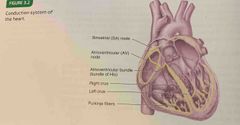
Back (Definition) |
|
|
|
Atria & ventricles pictured : |

Back (Definition) |
|
|
|
The difference between EDV (120 mL) & ESV (50 mL) is |
70 mL, representing for the SV. |
|
|
|
Heart rate (HR) |
The rate at which the heart pumps. |
|
|
|
Cardiac output (Q) (Formula & definition) |
HR X SV The overall performance of the heart. |
|
|
|
Cardiac output (Q) is the volume of |
Blood pumped by the heart/min. (mL blood/min) |
|
|
|
If an average person has a resting HR of 70bpm in the resting SV 70 mL/beat, cardiac output at rest would be : |
70bpm X 70 mL/min = 4,900 mL/min or 4.9 L/min |
|
|
|
Monitoring heart rate during exercise provides a good estimate of |
The amount of work that is being done at any given time. |
|
|
|
How to manually monitor heart rate : |
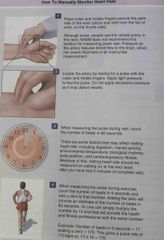
Back (Definition) |
|
|
|
Blood |
A fluid that circulates in the heart, arteries, capillaries, & veins, carrying nutrients & oxygen to all parts of the body. |
|
|
|
Conduction system of the heart : |
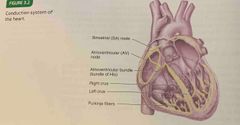
Back (Definition) |
|
|
|
Blood rids |
The body of waste products. |
|
|
|
Blood helps to regulate ___ & fight ___. |
Temperature Infections. |
|
|
|
Blood consists of cells suspended in |
A watery liquid called plasma. |
|
|
|
Plasma contains nutrients such as |
Glucose Hormones Blood clotting agents |
|
|
|
Red blood cells White blood cells Platelets |
Red blood cells White blood cells Platelets |
|
|
|
What do red blood cells do? |
They carry oxygen from the lungs throughout the body. |
|
|
|
How to manually monitor heart rate : |
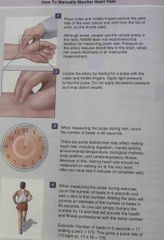
Back (Definition) |
|
|
|
What do platelets do? |
Help with clotting. |
|
|
|
Plasma makes up what percentage of the total volume of blood? |
~55% |
|
|
|
Atria & ventricles pictured : |
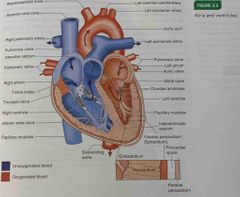
Back (Definition) |
|
|
|
The right ventricle receives the |
Deoxygenated blood from the right atrium, pumping it the lungs to be saturated with incoming oxygen. |
|
|
|
The left ventricle receives the |
Oxygenated blood from the left atrium, pumping it to the entire body. |
|
|
|
Why is each chamber of the heart separated from one another, major veins, & arteries via valves? |
To prevent backflow/spillage of blood back into the chambers. |
|
|
|
Valves include the |
Atrioventricular valves (tricuspid & mitral valves) Semilunar valves (pulmonary & aortic valves) |
|
|
|
Stroke volume (SV) |
The amount of blood pumped out of the heart with each contraction. |
|
|
|
Stroke volume (SV) is the difference between the |
Ventricular end diastolic-volume (EDV) & Ventricular end systolic-volume (ESV) |
|
|
|
In a typical heart what is the EDV & ESV? |
EDV : 120 mL of blood ESV : 50 mL of blood |
|
|
|
Red blood cells, white blood cells, & platelets make up what percentage of the total volume of blood? |
~45% |
|
|
|
Support mechanisms of blood : |
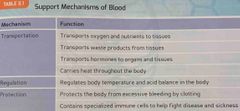
Back (Definition) |
|
|
|
Blood provides protection from excessive blood loss through |
It’s clotting mechanism, which seals off damaged tissue until a scar forms. |
|
|
|
Blood provides specialized |
Immune cells to fight against foreign toxins within the body, helping to reduce the risk of disease & illness. |
|
|
|
Blood vessels |
Network of hollow tubes that circulate blood throughout the body. |
|
|
|
Arteries |
Vessels that transport blood away from the heart. |
A=away |
|
|
Capillaries |
The smallest blood vessels that are the site of exchange of chemicals & water between the blood & tissues. |
|
|
|
What are the 3 major types of blood vessels? |
Arteries Capillaries Veins |
|
|
|
Veins |
Carry blood back to the heart. |
|
|
|
What is the largest artery in the body? |
The aorta. |
|
|
|
Support mechanisms of blood : |
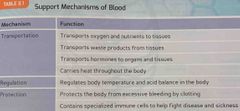
Back (Definition) |
|
|
|
Blood is a vital support mechanism, which provides |
Internal transportation, regulation, & protection systems for the HMS. |
|
|
|
Blood transports |
Life-sustaining oxygen to all bodily tissues, removing waste products. |
|
|
|
Blood transports hormones that act as |
Chemical messengers. |
|
|
|
Blood transports nutrients from the |
Gastrointestinal tract to various organs & tissues throughout the body. |
|
|
|
Blood helps remove heat |
From internal & external regions of the body. |
|
|
|
Blood helps regulate temperature by transferring |
Heat from the internal core out of the periphery of the body as blood circulates. |
|
|
|
As blood travels close to the skin it gives off |
Heat to the environment or can be cooled depending on the environment. |
|
|
|
Blood is essential in the regulation of |
pH levels (acid balance) in the body. Maintaining the water content of body cells. |
|
|
|
What do the branches of the aorta include? |
Medium sized arteries Carotid artery Subclavian artery Mesenteric arteries Renal artery Iliac artery |
5 types of arteries |
|
|
Respiratory pump |
Composed of skeletal structures (bones) & soft tissues muscles that work together to allow respiratory mechanics to occur & help pump blood back to the heart during inspiration. |
|
|
|
Breathing is divided into 2 phases, what are they? |
Inspiration (inhalation) Expiration (exhalation) |
|
|
|
Inspiration (inhalation) |
The process of actively contracting the inspiratory muscles to move air into the body. |
|
|
|
Expiration (exhalation) |
The process of actively/passively relaxing the inspiratory muscles to move air out of the body. |
|
|
|
Inspiratory ventilation is is active meaning that it requires |
Active contraction of inspiratory muscles to increase the thoracic cavity volume. |
|
|
|
When the thoracic cavity volume is increased |
The intrapulmonary pressure decreases. |
|
|
|
Well the intrapulmonary pressure decreases below that of the atmospheric pressure (every day pressure in the air), |
Air is drawn into the lungs. |
|
|
|
Inspiratory ventilation occurs in 2 forms, what are they? |
Normal resting state (quiet) breathing Heavy (deep, forced) breathing |
|
|
|
Normal breathing requires the use of |
The primary respiratory muscles (diaphragm, external intercostals). |
|
|
|
Heavy breathing requires The |
Additional use of the secondary respiratory muscles (scalenes, pectoralis minor). |
|
|
|
These medium size arteries further divide into |
Smaller arteries that are called aterioles. |
|
|
|
Expiratory ventilation can be both |
Active & passive. |
|
|
|
During normal breathing, expiratory ventilation is |
Passive as the results from the relaxation of the contracting inspiratory muscles. |
|
|
|
During heavy or forced breathing, expiratory ventilation relies on |
The activity of expiratory muscles to compress the thoracic cavity & forced air out. |
|
|
|
Breathing helps to regulate |
Blood flow back to the heart. |
|
|
|
What is the purpose of inhalation? |
To move air in & out of the body. |
|
|
|
The respiratory passages are divided 2 two categories, what are they? |
Conducting airways Respiratory airways |
|
|
|
The conducting airways consist of |
All the structures that air travels through before entering the respiratory airways. |
|
|
|
What provides gathering stations for air & oxygen to be directed into the body? |
The nasal & oral cavities Mouth Pharynx Larynx Trachea Bronchioles |
There are 7 |
|
|
The nasal & oral cavities, mouth, Ference, larynx, trachea, & bronchioles allows the incoming air to be |
Purified, humidified (or moisture added), & warmed or cooled to match body temp. |
|
|
|
Structures of the respiratory pump : |
Back (Definition) |
|
|
|
Arterioles |
Small terminal branches of an artery, which end in capillaries. |
|
|
|
Structures of the respiratory passages : |
Back (Definition) |
|
|
|
Diffusion |
The process of getting oxygen from the environment to the tissues of the body. |
|
|
|
The respiratory airways collect the channeled air coming from the |
Conducting airways. |
|
|
|
At the end of the bronchioles sits the |
Alveoli, which are made up of clusters of alveolar sacs. |
|
|
|
In the alveolar sac gases such as O2 & CO2 are |
Transported in & out of the bloodstream. |
|
|
|
The respiratory passages : |
Back (Definition) |
|
|
|
Structures of the respiratory pump : |
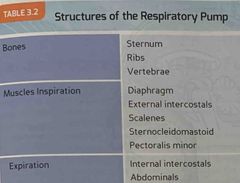
Back (Definition) |
|
|
|
Structures of the respiratory passages : |
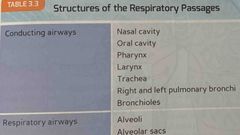
Back (Definition) |
|
|
|
Resting oxygen consumption the O2 is approximately |
3.5 mL of oxygen/kg of body weight/min |
|
|
|
The equation for oxygen consumption is known as the |
Fick equation. |
|
|
|
Venules |
Very small things that connect capillaries to larger things, collecting blood from the capillaries. |
|
|
|
According to the Fick equation, oxygen consumption (VO2) is a product of |
|
|
|
|
The respiratory passages : |

Back (Definition) |
|
|
|
VO2 max values can range anywhere from |
40-80 mL X kg^-1 X min^-1 ~11-23 METs |
|
|
|
What is the only way to determine VO2 Max? |
Directly measuring ventilation, oxygen consumption, & carbon dioxide production during a maximal exercise test. |
|
|
|
Resting oxygen consumption the O2 is approximately |

3.5 mL of oxygen/kg of body weight/min |
|
|
|
Any difficulty or change to normal breathing patterns can affect the normal response to exercise. Common and normal breathing scenario is associated with stress and anxiety include : |
Back (Definition) |
|
|
|
According to the Fick equation, oxygen consumption (VO2) is a product of |

|
|
|
|
What is the respiratory system also known as? |
The pulmonary system. |
|
|
|
The respiratory system |
A system of organs that collects oxygen from the external environment, transporting it to the bloodstream. |
|
|
|
Oxygen is brought into the |
Lungs removing carbon dioxide from the lungs to the outside air. |
|
|
|
What is the primary role of the respiratory system? |
To ensure proper cellular function. |
|
|
|
Any difficulty or change to normal breathing patterns can affect the normal response to exercise. Common and normal breathing scenario is associated with stress and anxiety include : |
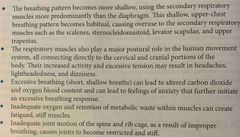
Back (Definition) |
|

